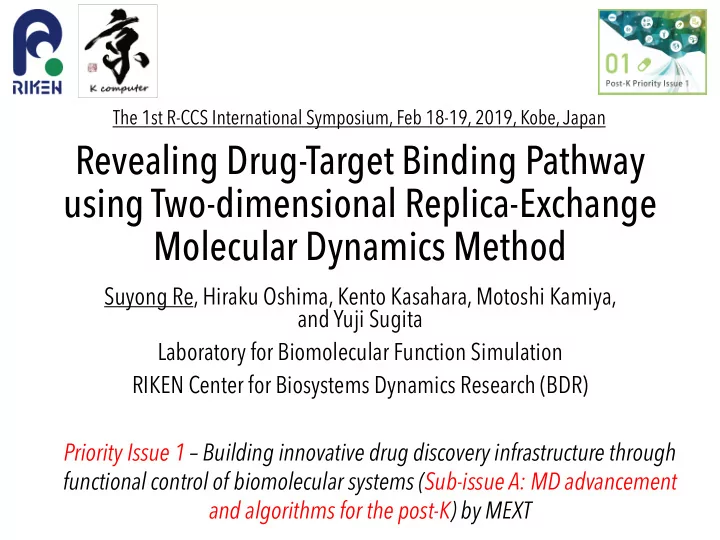

The 1st R-CCS International Symposium, Feb 18-19, 2019, Kobe, Japan Revealing Drug-Target Binding Pathway using Two-dimensional Replica-Exchange Molecular Dynamics Method Suyong Re, Hiraku Oshima, Kento Kasahara, Motoshi Kamiya, and Yuji Sugita Laboratory for Biomolecular Function Simulation RIKEN Center for Biosystems Dynamics Research (BDR) Priority Issue 1 – Building innovative drug discovery infrastructure through functional control of biomolecular systems (Sub-issue A: MD advancement and algorithms for the post-K) by MEXT
Molecular Dynamics, MD Simulation For analyzing biomolecular dynamics and functions d r i dt = d p i d p i dt = F i m r i ( t + ∆ t ) = r i ( t ) + p i m ∆ t p i ( t + ∆ t ) = p i ( t ) + F i ∆ t Levitt, M. Angew. Chemie Int. Ed. (2014) Nobel Prize in Chemistry 2013 M. Karplus, M. Levitt, and A. Warshel “ Development of multiscale models for complex chemical systems ”.
Evolution of MD Simulation Toward more realistic modeling, and longer timescale 1) McCammon et.al, Nature (1977) 2) Duan et al., Science (1998) 3) de Groot et al., Science (2001) 4) Shaw et al., Science (2010) 5) Whitford et al., PLOS Comput. Biol (2013) 6) Zhao et al., Nature (2013) (Slide from Dr. C. Kobayashi)
Highly scalable Enhanced sampling General purpose Leader : Y. Sugita Main developers : C. Kobayashi, J. Jung, Y. Matsunaga, T. Mori, T. Ando, K. Tamura, M. Kamiya This is free software under GPLv2 License. https://www.r-ccs.riken.jp/labs/cbrt/ Current version: 1.3.0 GENESIS 1.0 J. Jung, T. Mori et al. WIREs Comput. Mol. Sci. 5, 310-323 (2015)
Computational Drug Discovery From “Docking” to “Binding” Binding site ”Key” Ligand “Lock” Protein receptor St Static shape Fl Flexi xibility y and molecular comple co lementa tarity ity in interact action ion 5
Replica-Exchange MD (REMD) Overcome high energy barrier by parameter exchanges Avoid trapping Y. Sugita and Y. Okamoto, Chem. Phys. Lett. 314:141-151 (1999)
2D-REMD for Ligand Binding Enhanced sampling of ligand-binding events Multidimensional REMD: Y. Sugita, A. Kitao, and Y. Okamoto, J. Chem. Phys. 113: 6042-6051 (2000), MREM, REUS, H. Fukunishi, O. Watanabe, and S. Takada, J. Chem. Phys. 2002, 116 (20), 9058–9067, H-REMD First application: H. Kokubo et al. J. Comput. Chem. 34:2601-2614 (2013) RE with Solute Tempering (REST) Protein Ligand Ligand temperature Protein…Ligand distance RE Umbrella Sampling (REUS)
Src Kinase – Inhibitor Binding A key signaling kinase in cancer process Signal Src kinase ADP– P ADP (ATP) P Protein Protein ATP competitive inhibitor design based on the X-ray structure is limited Only a part of whole functional interactions is given.
Three Essential States Bound, TS, Encounter, Unbound states Protein Ligand Free energy Unbound state Encounter complex Bound state gREST/REUS simulations provide atomic-level details of these states, we will discuss them in the presentation.
Take-Home Message MD simulations using enhanced sampling techniques as gREST/REUS can provide the information of multiple bound poses, multiple intermediates, and multiple pathways in protein-ligand bindings with high statistical accuracy. The binding pathway information provides the functional interactions that cannot be seen in the X-ray structures , exploring new deign principle. GENESIS on K and post-K computers would be a promising tool for next-generation drug discovery.
Acknowledgement RIKEN Center for Biosystems Dynamics Research (BDR) Laboratory for Biomolecular Function Simulation Dr. Yuji Sugita – Team leader Dr. Hiraku Oshima About GENESIS usage Dr. Jung Jaewoon Dr. Kento Kasahara Dr. Chigusa Kobayashi Dr. Motoshi Kamiya (IMS) Dr. Ai Niitsu (RIKEN Wako) Prof. Michael Feig (MSU, USA) Priority Issue 1 – Building Innovative drug discovery infrastructure through functional control of biomolecular systems (Sub-issue A: MD advancement and algorithms for the post-K) Computational resources: K computer (Project ID: hp170254), FX10 in University of Tokyo (Project ID: hp170115) by HPCI system, and HOKUSAI (Project ID: G17016) by RIKEN Advanced Center for Computing and Communication. Thank you for your attention!
Recommend
More recommend